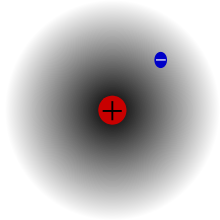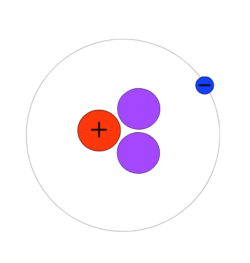Isotopes of hydrogen
Hydrogen (1H) has three naturally occurring isotopes, sometimes denoted 1H, 2H, and 3H. The first two of these are stable, while 3H has a half-life of 12.32 years. There are also heavier isotopes, which are all synthetic and have a half-life less than one zeptosecond (10−21 second). Of these, 5H is the most stable, and 7H is the least.[2][3]
| |||||||||||||||||||||||||||||
| Standard atomic weight Ar, standard(H) |
| ||||||||||||||||||||||||||||
|---|---|---|---|---|---|---|---|---|---|---|---|---|---|---|---|---|---|---|---|---|---|---|---|---|---|---|---|---|---|
Hydrogen is the only element whose isotopes have different names in common use today: the 2H (or hydrogen-2) isotope is deuterium[4] and the 3H (or hydrogen-3) isotope is tritium.[5] The symbols D and T are sometimes used for deuterium and tritium. The IUPAC accepts the D and T symbols, but recommends instead using standard isotopic symbols (2H and 3H) to avoid confusion in the alphabetic sorting of chemical formulas.[6] The ordinary isotope of hydrogen, with no neutrons, is sometimes called protium.[7] (During the early study of radioactivity, some other heavy radioactive isotopes were given names, but such names are rarely used today.)
List of isotopes
| Nuclide[8] |
Z | N | Isotopic mass (Da)[9] [n 1] |
Half-life [resonance width] |
Decay mode [n 2] |
Daughter isotope [n 3] |
Spin and parity [n 4][n 5] |
Natural abundance (mole fraction) | |
|---|---|---|---|---|---|---|---|---|---|
| Normal proportion | Range of variation | ||||||||
| 1H | 1 | 0 | 1.00782503224(9) | Stable[n 6][n 7] | 1/2+ | 0.999885(70) | 0.999816–0.999974 | ||
| 2H (D)[n 8] | 1 | 1 | 2.01410177811(12) | Stable | 1+ | 0.000115(70)[n 9] | 0.000026–0.000184 | ||
| 3H (T)[n 10] | 1 | 2 | 3.01604928199(23) | 12.32(2) y | β− | 3 He |
1/2+ | Trace[n 11] | |
| 4 H |
1 | 3 | 4.02643(11) | 1.39(10)×10−22 s [3.28(23) MeV] |
n | 3 H |
2− | ||
| 5 H |
1 | 4 | 5.03531(10) | > 9.1×10−22 s [< 0.5 MeV] |
2n | 3 H |
(1/2+) | ||
| 6 H |
1 | 5 | 6.04496(27) | 2.90(70)×10−22 s [1.6(4) MeV] |
3n | 3 H |
2−# | ||
| 4n | 2 H | ||||||||
| 7 H |
1 | 6 | 7.05275(108)# | 2.3×10−23 s | 4n | 3 H |
1/2+# | ||
- ( ) – Uncertainty (1σ) is given in concise form in parentheses after the corresponding last digits.
-
Modes of decay:
n: Neutron emission - Bold symbol as daughter – Daughter product is stable.
- ( ) spin value – Indicates spin with weak assignment arguments.
- # – Values marked # are not purely derived from experimental data, but at least partly from trends of neighboring nuclides (TNN).
- Unless proton decay occurs.
- This and 3He are the only stable nuclides with more protons than neutrons.
- Produced during Big Bang nucleosynthesis.
- Tank hydrogen has a 2
H
abundance as low as 3.2×10−5 (mole fraction). - Produced during Big Bang nucleosynthesis, but not primordial, as all such atoms have since decayed to 3He.
- Cosmogenic
Hydrogen-1 (protium)

1H (atomic mass 1.007825032241(94) Da) is the most common hydrogen isotope with an abundance of more than 99.98%. Because the nucleus of this isotope consists of only a single proton, it is given the formal name protium.
The proton has never been observed to decay, and hydrogen-1 is therefore considered a stable isotope. Some grand unified theories proposed in the 1970s predict that proton decay can occur with a half-life between 1031 and 1036 years. If this prediction is found to be true, then hydrogen-1 (and indeed all nuclei now believed to be stable) are only observationally stable. To date, experiments have shown that the minimum proton half-life is in excess of 1034 years.
Hydrogen-2 (deuterium)

2H (atomic mass 2.01410177811(12) Da), the other stable hydrogen isotope, is known as deuterium and contains one proton and one neutron in its nucleus. The nucleus of deuterium is called a deuteron. Deuterium comprises 0.0026–0.0184% (by population, not by mass) of hydrogen samples on Earth, with the lower number tending to be found in samples of hydrogen gas and the higher enrichment (0.015% or 150 ppm) typical of ocean water. Deuterium on Earth has been enriched with respect to its initial concentration in the Big Bang and the outer solar system (about 27 ppm, by atom fraction) and its concentration in older parts of the Milky Way galaxy (about 23 ppm). Presumably the differential concentration of deuterium in the inner solar system is due to the lower volatility of deuterium gas and compounds, enriching deuterium fractions in comets and planets exposed to significant heat from the Sun over billions of years of solar system evolution.
Deuterium is not radioactive, and does not represent a significant toxicity hazard. Water enriched in molecules that include deuterium instead of protium is called heavy water. Deuterium and its compounds are used as a non-radioactive label in chemical experiments and in solvents for 1H-NMR spectroscopy. Heavy water is used as a neutron moderator and coolant for nuclear reactors. Deuterium is also a potential fuel for commercial nuclear fusion.
Hydrogen-3 (tritium)

3H (atomic mass 3.01604928199(23) Da) is known as tritium and contains one proton and two neutrons in its nucleus. It is radioactive, decaying into helium-3 through β− decay with a half-life of 12.32 years.[10] Trace amounts of tritium occur naturally because of the interaction of cosmic rays with atmospheric gases. Tritium has also been released during nuclear weapons tests. It is used in thermonuclear fusion weapons, as a tracer in isotope geochemistry, and specialized in self-powered lighting devices.
The most common method of producing tritium is by bombarding a natural isotope of lithium, lithium-6, with neutrons in a nuclear reactor.
Tritium was once used routinely in chemical and biological labeling experiments as a radiolabel, which has become less common in recent times. D-T nuclear fusion uses tritium as its main reactant, along with deuterium, liberating energy through the loss of mass when the two nuclei collide and fuse at high temperatures.
Hydrogen-4
4H (atomic mass is 4.02643(11) Da) contains one proton and three neutrons in its nucleus. It is a highly unstable isotope of hydrogen. It has been synthesised in the laboratory by bombarding tritium with fast-moving deuterium nuclei.[11] In this experiment, the tritium nucleus captured a neutron from the fast-moving deuterium nucleus. The presence of the hydrogen-4 was deduced by detecting the emitted protons. It decays through neutron emission into hydrogen-3 (tritium) with a half-life of about 139 ± 10 yoctoseconds (or (1.39±0.10)×10−22 seconds).[12]
In the 1955 satirical novel The Mouse That Roared, the name quadium was given to the hydrogen-4 isotope that powered the Q-bomb that the Duchy of Grand Fenwick captured from the United States.
Hydrogen-4.1
Hydrogen-4.1 is like helium-4 in having 2 protons and 2 neutrons. However one of its electrons is replaced by a muon. Since the orbital of the muon is very near the atomic nucleus, that muon can be seen as a part of the nucleus. The whole atom can be described as: "The atomic nucleus is formed by 1 muon, 2 protons and 2 neutrons, with only one electron outside", so it can be considered as one isotope of hydrogen, and an exotic atom too. A muon's weight is 0.1U,so the atom's name is Hydrogen-4.1(4.1H). The Hydrogen-4.1 atom can react with other atoms. Its behavior is that of a hydrogen atom and not a noble helium atom.[13]
Hydrogen-5
5H is a highly unstable isotope of hydrogen. The nucleus consists of a proton and four neutrons. It has been synthesised in the laboratory by bombarding tritium with fast-moving tritium nuclei.[11][14] In this experiment, one tritium nucleus captures two neutrons from the other, becoming a nucleus with one proton and four neutrons. The remaining proton may be detected, and the existence of hydrogen-5 deduced. It decays through double neutron emission into hydrogen-3 (tritium) and has a half-life of at least 910 yoctoseconds (9.1 × 10−22 seconds).[12]
Hydrogen-6
6H decays either through triple neutron emission into hydrogen-3 (tritium) or quadruple neutron emission into hydrogen-2 (deuterium) and has a half-life of 290 yoctoseconds (2.9 × 10−22 seconds).[12]
Hydrogen-7
7H consists of a proton and six neutrons. It was first synthesized in 2003 by a group of Russian, Japanese and French scientists at RIKEN's Radioactive Isotope Beam Factory by bombarding hydrogen with helium-8 atoms. In the resulting reaction, all six of the helium-8's neutrons were donated to the hydrogen's nucleus. The two remaining protons were detected by the "RIKEN telescope", a device composed of several layers of sensors, positioned behind the target of the RI Beam cyclotron.[3] Hydrogen-7 has a half life of 23 yoctoseconds (2.3×10−23 s).[15]
Decay chains
The majority of heavy hydrogen isotopes decay directly to 3H, which then decays to the stable isotope 3He. However, 6H has occasionally been observed to decay directly to stable 2H.
Decay times are in yoctoseconds for all isotopes except 3H, which is expressed in years.
See also
- Hydrogen isotope biogeochemistry
- Muonium – acts like an exotic light isotope of hydrogen

References
- Meija, Juris; et al. (2016). "Atomic weights of the elements 2013 (IUPAC Technical Report)". Pure and Applied Chemistry. 88 (3): 265–91. doi:10.1515/pac-2015-0305.
- Y. B. Gurov; et al. (2004). "Spectroscopy of superheavy hydrogen isotopes in stopped-pion absorption by nuclei". Physics of Atomic Nuclei. 68 (3): 491–497. Bibcode:2005PAN....68..491G. doi:10.1134/1.1891200.
- A. A. Korsheninnikov; et al. (2003). "Experimental Evidence for the Existence of 7H and for a Specific Structure of 8He". Physical Review Letters. 90 (8): 082501. Bibcode:2003PhRvL..90h2501K. doi:10.1103/PhysRevLett.90.082501. PMID 12633420.
- IUPAC, Compendium of Chemical Terminology, 2nd ed. (the "Gold Book") (1997). Online corrected version: (2006–) "deuterium". doi:10.1351/goldbook.D01648
- IUPAC, Compendium of Chemical Terminology, 2nd ed. (the "Gold Book") (1997). Online corrected version: (2006–) "tritium". doi:10.1351/goldbook.T06513
- International Union of Pure and Applied Chemistry (2005). Nomenclature of Inorganic Chemistry (IUPAC Recommendations 2005). Cambridge (UK): RSC–IUPAC. ISBN 0-85404-438-8. p. 48. Electronic version.
- IUPAC, Compendium of Chemical Terminology, 2nd ed. (the "Gold Book") (1997). Online corrected version: (2006–) "protium". doi:10.1351/goldbook.P04903
- Half-life, decay mode, nuclear spin, and isotopic composition is sourced in:
Audi, G.; Kondev, F. G.; Wang, M.; Huang, W. J.; Naimi, S. (2017). "The NUBASE2016 evaluation of nuclear properties" (PDF). Chinese Physics C. 41 (3): 030001. Bibcode:2017ChPhC..41c0001A. doi:10.1088/1674-1137/41/3/030001. - Wang, M.; Audi, G.; Kondev, F. G.; Huang, W. J.; Naimi, S.; Xu, X. (2017). "The AME2016 atomic mass evaluation (II). Tables, graphs, and references" (PDF). Chinese Physics C. 41 (3): 030003-1–030003-442. doi:10.1088/1674-1137/41/3/030003.
- G. L. Miessler; D. A. Tarr (2004). Inorganic Chemistry (3rd ed.). Pearson Prentice Hall. ISBN 978-0-13-035471-6.
- G. M. Ter-Akopian; et al. (2002). "Hydrogen-4 and Hydrogen-5 from t+t and t+d transfer reactions studied with a 57.5-MeV triton beam". AIP Conference Proceedings. 610: 920–924. Bibcode:2002AIPC..610..920T. doi:10.1063/1.1470062.
- Audi, Georges; Wapstra, Aaldert Hendrik; Thibault, Catherne; Blachot, Jean; Bersillon, Olivier (2003). "The NUBASE evaluation of nuclear and decay properties" (PDF). Nuclear Physics A. 729 (1): 3–128. Bibcode:2003NuPhA.729....3A. CiteSeerX 10.1.1.692.8504. doi:10.1016/j.nuclphysa.2003.11.001. Archived from the original (PDF) on 2011-07-20.
- Fleming, D. G.; Arseneau, D. J.; Sukhorukov, O.; Brewer, J. H.; Mielke, S. L.; Schatz, G. C.; Garrett, B. C.; Peterson, K. A.; Truhlar, D. G. (28 Jan 2011). "Kinetic Isotope Effects for the Reactions of Muonic Helium and Muonium with H2". Science. 331 (6016): 448–450. doi:10.1126/science.1199421. PMID 21273484.
- A. A. Korsheninnikov; et al. (2001). "Superheavy Hydrogen 5H". Physical Review Letters. 87 (9): 92501. Bibcode:2001PhRvL..87i2501K. doi:10.1103/PhysRevLett.87.092501. PMID 11531562.
- "Isotope data for hydrogen-7 in the Periodic Table". periodictable.com. Retrieved 2020-02-07.
Further reading
- Dumé, B. (7 March 2003). "Hydrogen-7 makes its debut". Physics World.
